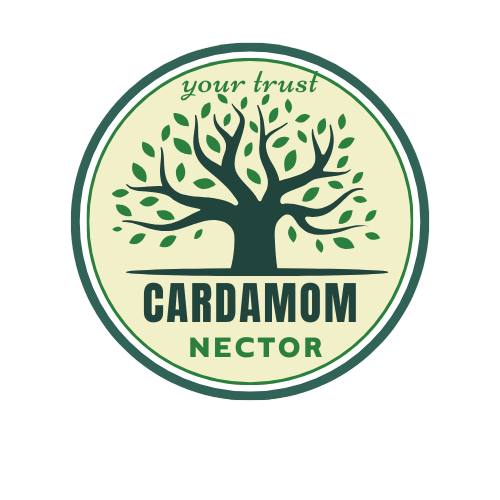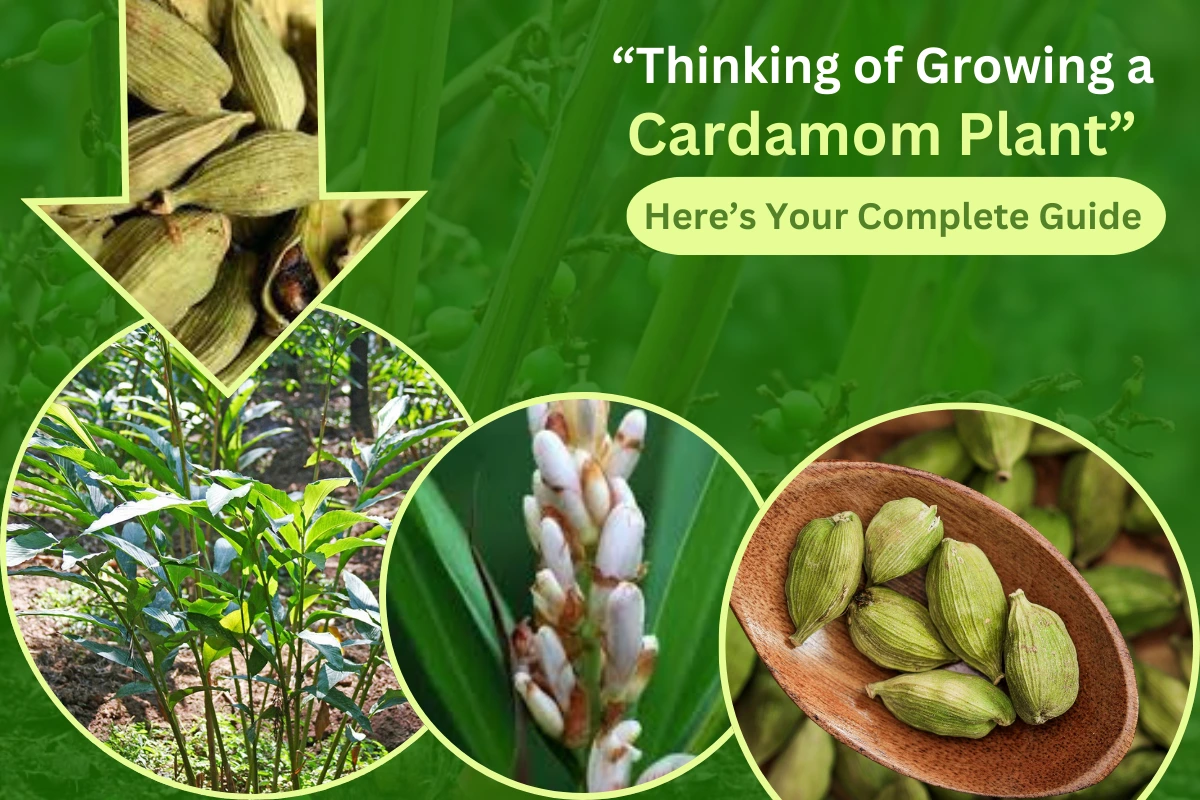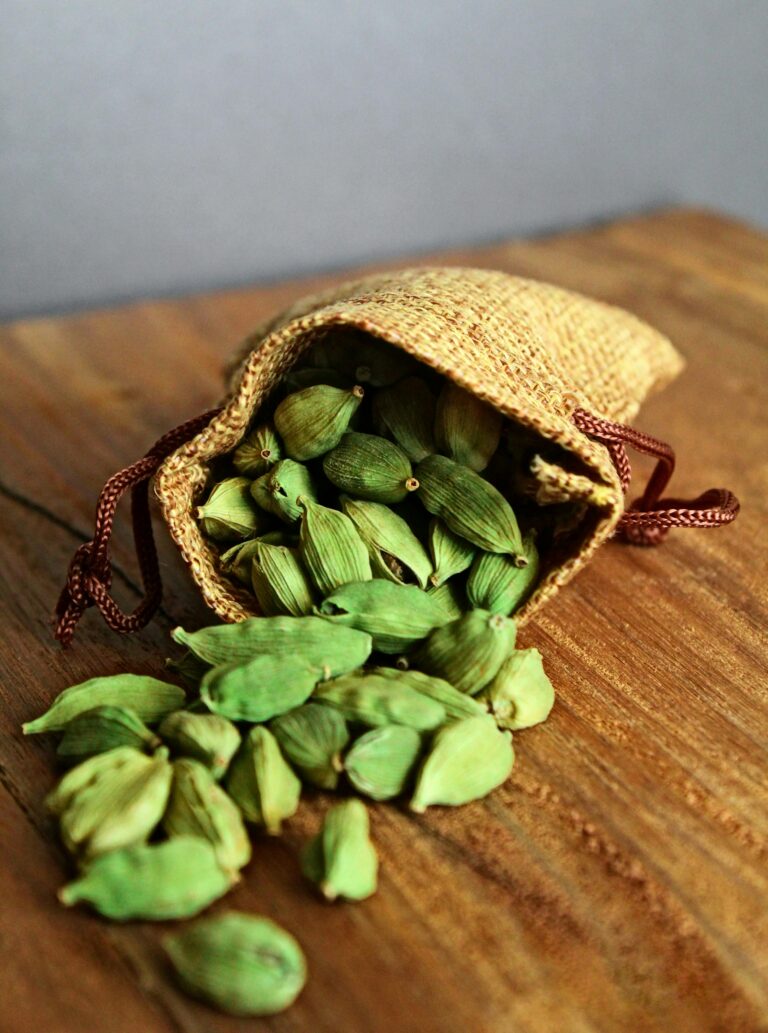How To Grow Cardamom at Home: Amazing and Complete Guide from Seed to Harvest
How to Grow and Care for Cardamom at Home
As a passionate home cook and gardener, combining my love for flavorful spices and lush greenery felt like a natural step. Deciding to grow cardamom, with its enchanting aroma and vibrant pods, wasn’t just about cultivating a spice—it was about embracing an experience. Its elegant green leaves and delicate flowers bring beauty and charm to any space, whether in pots, garden beds, or indoors.
Driven by curiosity, I began experimenting with growing cardamom at home, testing soil mixes, finding the perfect spot, and learning through trial and error. Watching it thrive has been rewarding, adding freshness and beauty to my little garden. I’m thrilled to share everything I’ve learned so you can grow cardamom at home and enjoy this exotic spice firsthand!
Green Cardamom Plant Profile: Everything You Need to Know
Green Cardamom known as the “Queen of Spices,” is cherished for its aromatic pods and lush tropical beauty. A favorite among gardeners and cooks alike, this plant adds elegance to gardens and flavor to dishes. Whether you’re growing it at home or exploring its botanical traits, this guide covers everything you need to know about cardamom’s appearance, habitat, and care.
Botanical Name and Classification
Cardamom, scientifically known as Elettaria cardamomum, belongs to the Zingiberaceae family, which includes ginger and turmeric. This family is well-known for its aromatic plants, many of which are used for culinary and medicinal purposes. As a herbaceous perennial, Cardamom is cherished for its unique flavor and fragrance, making it one of the most valuable spices in the world.
Cardamom plants thrive in tropical climates, where conditions mirror those in their native regions in India, Bhutan, and Indonesia. Their natural taller trees often overshadow these plants with taller trees, which provide the partial shade they love.
Physical Description of the Cardamom Plant

Cardamom is a large, lush plant with striking features. Here’s a breakdown of its physical description:
Height:
Cardamom plants can grow between 10 and 15 feet tall, with some plants reaching even greater heights in their natural habitat. They have a clumping growth habit, which means the plant grows in a cluster of stems, making it appear even more robust and tropical.
Leaves:
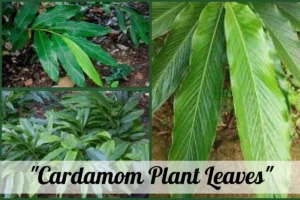
The leaves are long, narrow, and lance-shaped, growing up to 3 feet long. They are vibrant green, giving the plant an exotic and fresh look. The leaves grow from the base of the plant and add significant ornamental value to your garden.
Pods:
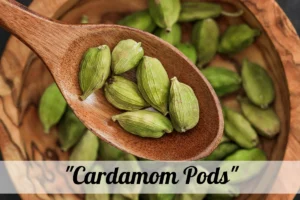
The famous spice comes from the plant’s green pods. These pods are typically green, 3-4 cm long, though some varieties can appear slightly yellowish. Small, aromatic black seeds are harvested and dried inside the pods to produce the spice.
Flowers:
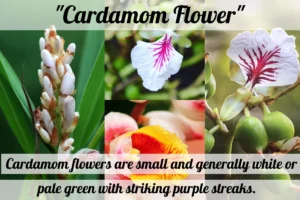
Cardamom flowers are small, delicate, and generally white or pale green with striking purple streaks. They appear at the base of the plant and are borne on spikes. Each flower is beautifully intricate, with three sepals and three petals. Depending on the region, they bloom mainly during the rainy season, usually in late summer or early fall.
Native Regions and Natural Habitat
Cardamom is native to the tropical regions of India, Bhutan, and Indonesia, where it thrives under the shade of taller trees. It grows in the wild in the lush, high-altitude forests of the Western Ghats in India, where it flourishes in warm, humid climates. Cardamom plants need abundant rainfall and a consistent temperature range to grow successfully.
In its natural habitat, cardamom is often found at altitudes ranging from 1,000 to 1,500 meters above sea level. These cooler, moist environments offer the perfect conditions for the plant to thrive, providing the necessary humidity and shade to grow tall and strong. Recreating this environment in your home garden or pots is key to successful cultivation.
Growth Requirements for Cardamom
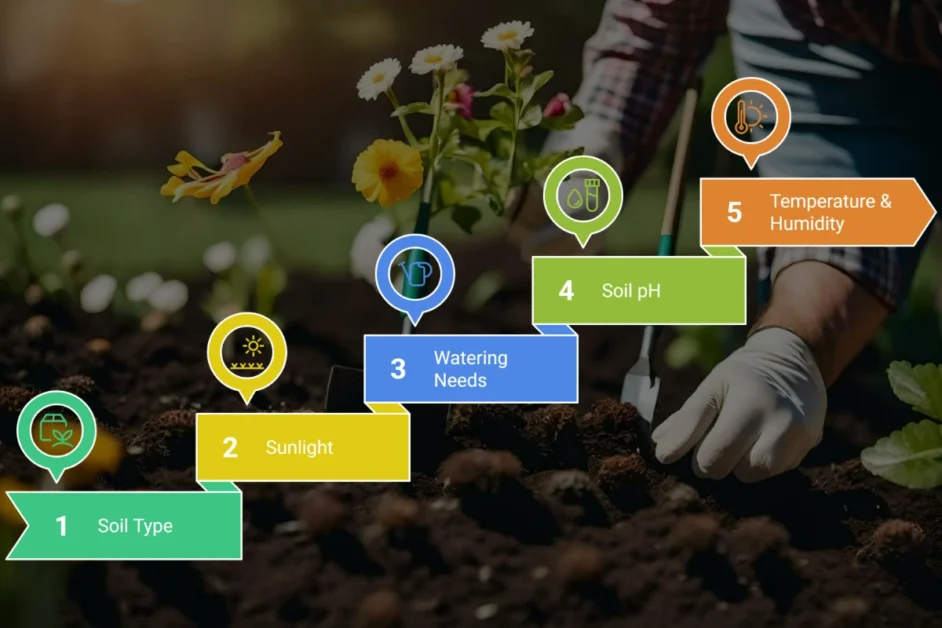
To grow Cardamom at home successfully, it’s essential to understand its growth requirements. Here’s a breakdown of what your cardamom plant needs to thrive:
- Soil Type
- Sunlight
- Watering Needs
- Soil pH
- Temperature and Humidity
Each of these elements is crucial, and we’ll explore them in detail below to help you create the perfect environment for your cardamom plant.
Bloom Time and Flower Color
Cardamom typically blooms in the monsoon season, when the plant receives plenty of moisture. The flowers appear in clusters, usually white or pale green, with purple streaks along the petals. These flowers are small but quite intricate, emitting a mild fragrance. The blooming period typically lasts 4-6 weeks, depending on the climate and the plant’s health. The flowers eventually give way to the green pods that mature into the flavorful spice we know and love.
Hardiness Zones and Lifespan
Hardiness Zones:
Cardamom plants thrive best in USDA hardiness zones 10 to 12, tropical and subtropical regions. These zones offer the warmth, humidity, and rainfall that Cardamom requires. If you live in a colder climate, growing Cardamom indoors in pots or using greenhouses is a great option to replicate these conditions.
Lifespan:
Cardamom can live for 10 to 15 years under the right conditions. However, its most productive years are usually between 4 and 8 years. As the plant matures, its ability to produce fruit diminishes slightly, but it can continue to thrive for many years with proper care.
Quick Reference Table: Cardamom Plant at a Glance
| Feature | Details |
|---|---|
| Common Names | Cardamom, Elaichi, Queen of Spices |
| Botanical Name | Elettaria cardamomum |
| Plant Size | 10–15 feet tall |
| Plant Age | Up to 15 years |
| Fruit Production | 2–3 kilograms per plant per year |
| Soil Type | Rich, loamy soil |
| Sunlight Requirement | Partial shade |
| Watering Needs | Consistently moist but not waterlogged |
| Soil pH | 5.5–6.5 |
| Bloom Time | Monsoon season |
| The Flower Color | White or pale green with purple streaks |
| Hardiness Zones | 10–12 |
| Native Area | India, Bhutan, Indonesia |
Reasons to Plant Green Cardamom at Home
1. Fresh, Organic Spice at Your Fingertips
Imagine stepping into your garden or balcony and plucking fresh green cardamom pods right from the plant. Not only does this give you a wonderful sense of accomplishment, but it also means you have a continuous supply of organic Cardamom for all your culinary creations. No more worrying about store-bought spices losing their flavor over time. Freshly harvested green Cardamom boasts a robust, aromatic flavor that can elevate your dishes, from curries to desserts. Plus, you can rest assured that you’re growing your spice without harmful pesticides or chemicals, making it the healthiest option for you and your family.
2. Cost Savings Compared to Store-Bought Green Cardamom
Let’s face it – high-quality green Cardamom can be pretty pricey at the store. Growing your plants at home can save money in the long run. While the initial investment might include purchasing seeds or young plants, once your cardamom plants start producing, you’ll have a steady supply of fresh pods. Cardamom is a relatively slow-growing plant, so it may take a couple of years to reach full production. Still, once it does, you’ll notice a significant difference in how much money you save compared to constantly buying Cardamom from the store.
3. Aesthetic Appeal as a Lush Green Plant
Besides the wonderful flavor and aroma, green Cardamom is a beautiful addition to any garden or even a potted plant indoors. With its tall, graceful leaves and unique pods, this plant adds a touch of elegance and greenery to your space. Whether you’re planting it in a garden bed, a pot, or even a garden bed (a traditional gardening setup), green Cardamom will thrive and enhance the beauty of your surroundings. The lush green foliage creates a refreshing atmosphere, and when the plant begins to flower, it brings even more visual appeal with delicate, aromatic blossoms.
4. Environmental Benefits (Reducing Carbon Footprint)
Growing green Cardamom at home has its share of environmental benefits. Growing spices reduces your reliance on packaged products transported from distant regions, often contributing to a higher carbon footprint. Not only are you saving packaging waste, but you’re also lowering the demand for large-scale farming and its associated environmental costs. When you plant green Cardamom in your garden, you contribute to a more sustainable lifestyle by decreasing the need for commercially farmed spices and minimizing your impact on the planet.
Climate and Environment: Understanding When and Where to Plant
Understanding its climate and environmental needs is essential to successfully growing green Cardamom at home. Green Cardamom thrives in warm, humid environments, ideal for tropical and subtropical climates.
1. Ideal Temperature for Plantation:
The best temperature for growing green Cardamom is between 65°F and 95°F (18°C to 35°C). Cardamom plants are sensitive to frost and extreme temperatures, so they should be grown in warm areas throughout the year. If you live in a region with cooler winters, you can grow Cardamom in pots and bring them inside during the colder months.
2. Humidity and Sunlight Requirements:
Green Cardamom thrives in high humidity—ideally around 60% to 80%—so make sure you plant it in a naturally humid location or maintain moisture around it by misting it. As for sunlight, green Cardamom prefers indirect light. While it needs some sunlight to grow, it’s best to place it in a location that gets bright, filtered light for about 4 to 6 hours daily. Avoid direct, harsh sunlight, as it can scorch the leaves.
Selection of Soil: Meeting Soil Requirements
Green Cardamom is particular about its soil; having the correct soil type is crucial for its growth.
Type of Soil:
Cardamom prefers loamy, rich, and well-drained soil high in organic matter. A good mixture of compost, peat, and perlite can help create an ideal environment for the plant.
Soil pH Levels: Cardamom thrives in slightly acidic to neutral soil, with a pH level between 6.0 and 7.0. Too alkaline soil can hinder nutrient absorption and stunt the plant’s growth.
Drainage:
Good drainage is essential to avoid waterlogging, which can cause root rot. You can improve drainage by adding sand or perlite to the soil mix.
Soil Testing Tips:
Before planting, test the soil to ensure it meets the required pH and nutrient levels. A simple soil test kit at gardening stores will help determine your soil’s pH and nutrient content. Alternatively, you can send a soil sample to a local laboratory for a more detailed analysis. A healthy soil mix ensures your cardamom plants will grow strong and productive.
Watering Needs: How Much and How Often to Water
Watering is a delicate balance when growing green Cardamom. While it loves moisture, overwatering can lead to root rot, especially in poorly draining soil.
How Much to Water:
Green Cardamom prefers consistent moisture but not soggy conditions. Water your plants whenever the top inch of soil feels dry. Aim to keep the soil consistently moist but not drenched. You may need to water more frequently in the hot summer, while the watering schedule can be reduced during the cooler months.
How Often to Water:
Typically, water your green cardamom plant every 2-3 days during warmer weather and once a week during winter. Always check the moisture levels before watering to ensure you’re not overwatering.
Selecting a Plant Site: Where to Place Your Green Cardamom
When deciding where to plant your green Cardamom, it’s essential to consider both sunlight and protection from the elements.
Ideal Site Selection:
Cardamom grows best in a partially shaded spot with a mix of sunlight and shade. Place it near a window with filtered sunlight if you’re planting it indoors. Outdoors, consider spots that get partial shade during the hottest part of the day, such as under taller plants or trees that provide some cover.
Spacing, Depth, and Support: Proper Planting Tips
Spacing: When planting green Cardamom, give each plant 3 to 4 feet of space in between. Cardamom plants need room to grow and spread, and overcrowding can hinder air circulation, which may lead to diseases.
Depth:
Plant green Cardamom at a shallow depth—just deep enough to cover the roots and the base of the stem, around 2 to 3 inches deep. Be careful not to bury the plant too deeply, as this could stunt its growth.
Support:
Cardamom plants can grow quite tall (up to 4 feet), so providing support is a good idea. Use stakes or a natural support structure to keep the plant upright and prevent it from bending under its weight. This activity also helps improve air circulation around the plant.
In Short; Best Time to Plant Green Cardamom: The best time to plant green Cardamom is during the warm season, preferably in spring or early summer, when the soil is warm and the risk of frost has passed. You can start the plant indoors and transfer it outside in cooler climates once the weather warms up.
Methods of Growing Green Cardamom
Green Cardamom is a tropical plant that requires specific care and attention, but with the proper methods, you can grow it successfully in various settings. Whether you want to grow it in pots, garden beds, or indoors, the following guide will help you choose the best growing method for your needs.
Growing Green Cardamom in Pots: Step-by-Step Process
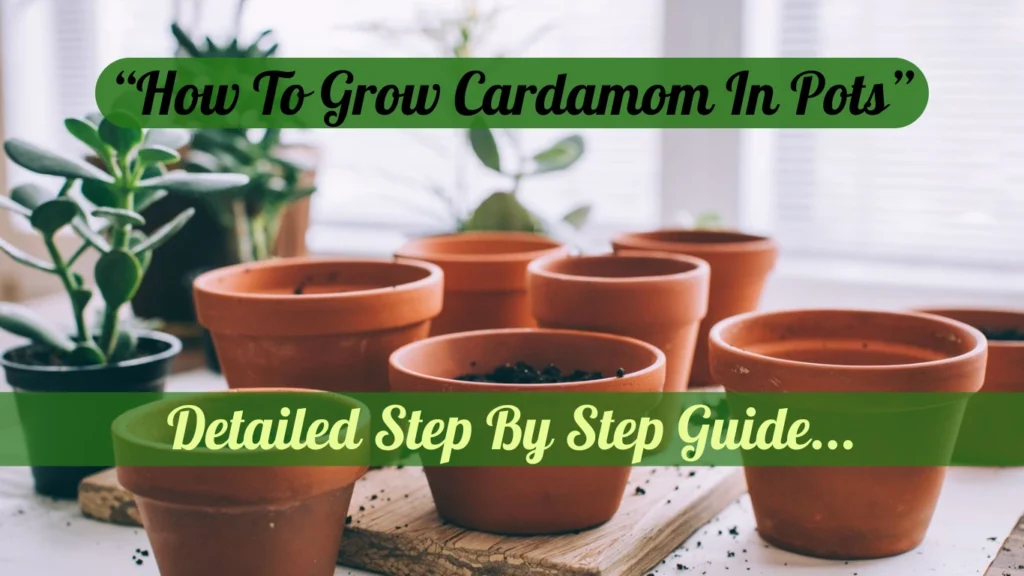
Growing cardamom in pots is a great way to cultivate this aromatic spice, mainly if you have limited space or live in a non-tropical region. You can grow cardamom indoors or on your balcony with the proper care, a controlled environment, and patience. Follow this step-by-step guide to ensure healthy growth and a bountiful harvest.
Step 1: Choosing the Right Pot
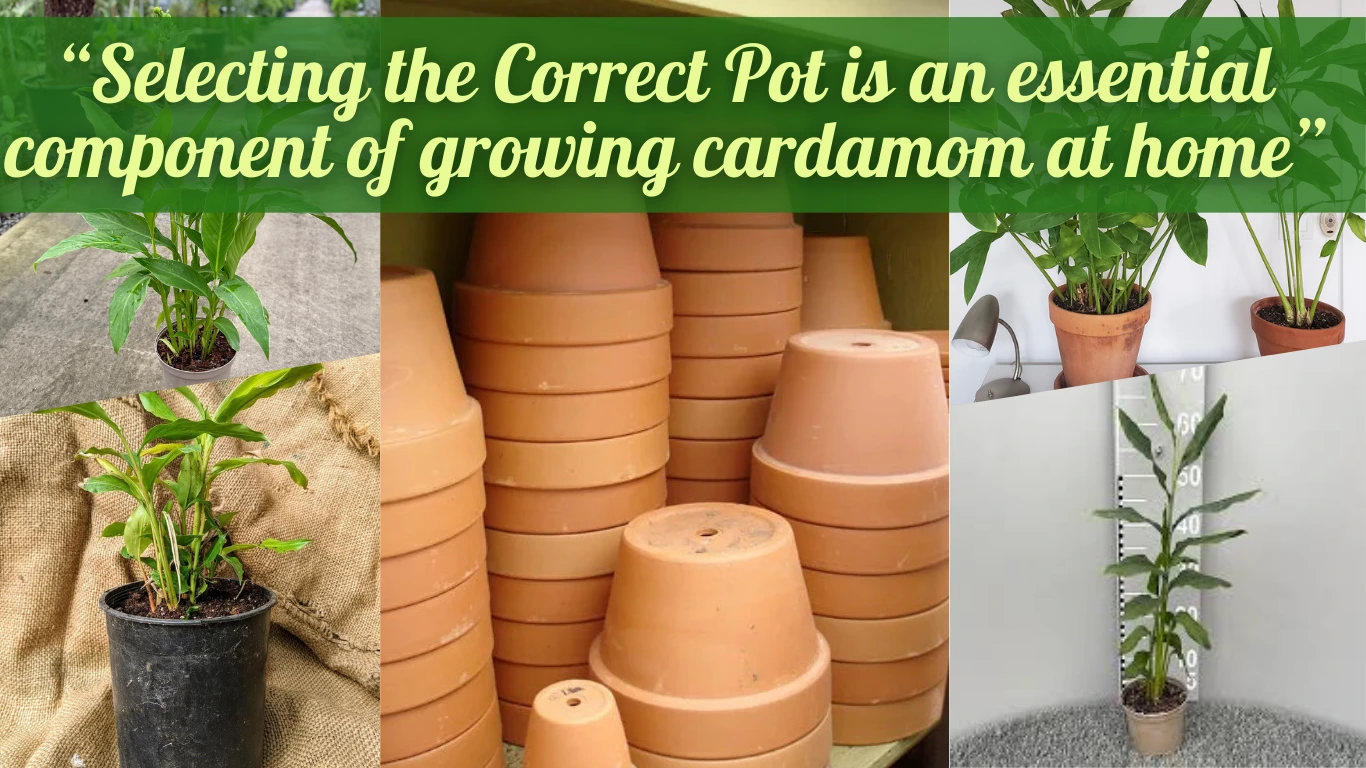
Green cardamom requires ample growing space, so choosing the right pot is essential. Select a large, deep pot with a diameter of 12 to 18 inches (30 to 45 cm). It’s also important that the pot has drainage holes to prevent waterlogging and root rot.
Step 2: Soil Mix for Potting
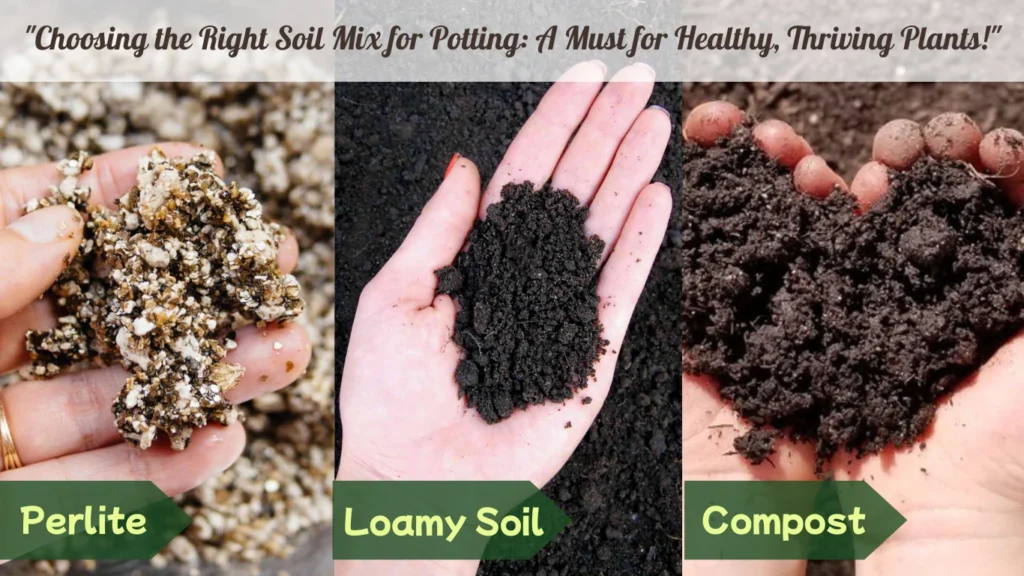
The soil for Cardamom in pots should be loamy, well-draining, and rich in organic matter. You can create your potting mix by combining the following:
- 1 part compost
- 1 part perlite or coarse sand
- 2 parts loamy soil
This mix will ensure proper drainage while maintaining enough moisture for healthy growth. The soil pH should be slightly acidic, around 6.0 to 7.0.
Step 3: Planting Cardamom Seeds or Seedlings
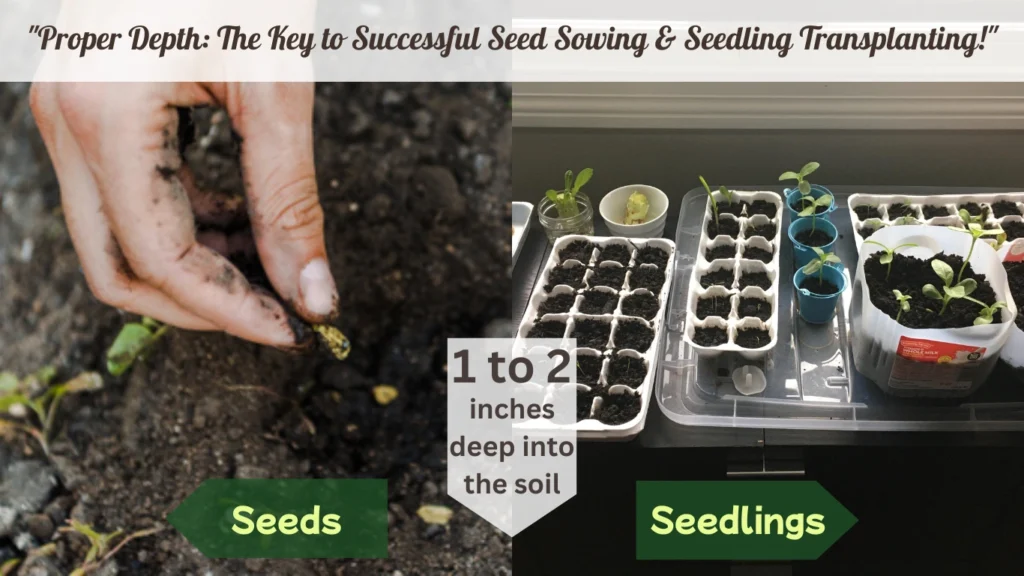
Fill the pot with the soil mix, leaving about an inch from the top for watering. Plant cardamom seeds or young plants 1 to 2 inches deep into the soil. If you’re starting from seeds, be patient; germination can take several weeks.
Step 4: Location and Light
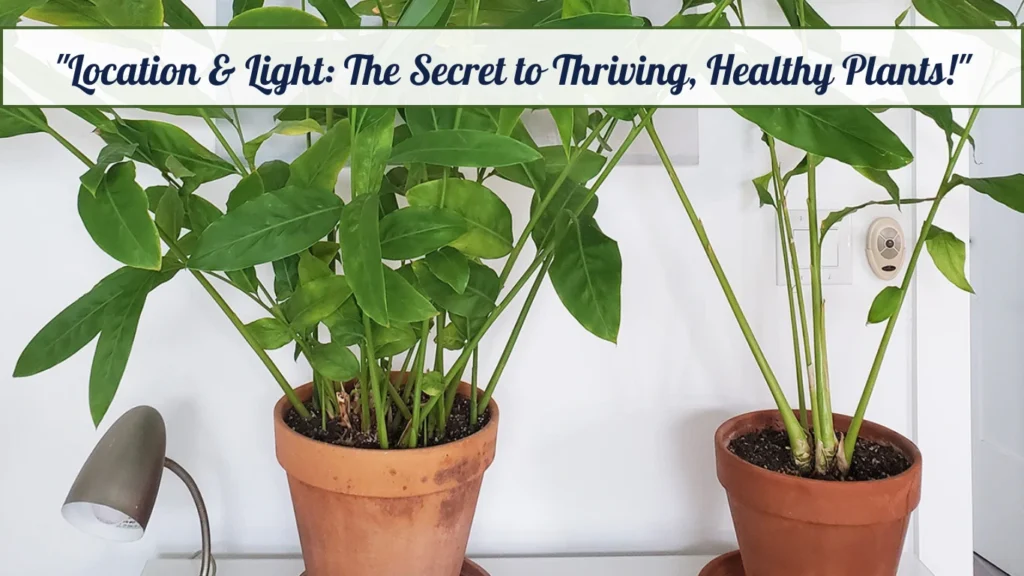
Cardamom plants thrive in bright, indirect sunlight. Place the pot in a spot where it gets around 4-6 hours of filtered sunlight daily. If you’re growing indoors, a south-facing window is ideal, but ensure the plant doesn’t get direct harsh sunlight, which can scorch the leaves.
Step 5: Watering and Humidity
Water your cardamom plant regularly, ensuring the soil remains moist but not soggy. Be mindful of under watering, but also avoid waterlogging. A 50-60% humidity level is ideal for green Cardamom, so consider using a humidity tray or placing the pot in a location with natural humidity.
Step 6: Fertilizing and Care
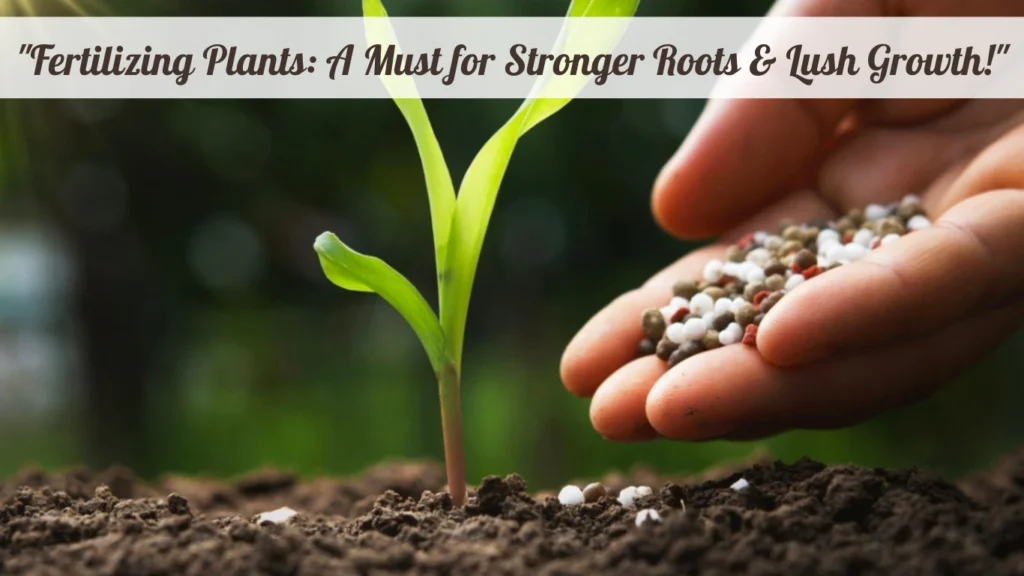
Feed the plant every 4-6 weeks during the growing season with a balanced, water-soluble fertilizer. You can also add organic compost to provide nutrients. Check the pot regularly for pests and remove dead leaves to keep the plant healthy.
Growing Green Cardamom in Garden Beds
Step 1: Preparing the Garden Soil
Before planting, loosen the soil to a depth of about 6 to 8 inches. Cardamom prefers loamy, well-drained soil with a slightly acidic pH of 6.0 to 7.0. Mix in plenty of organic compost or well-rotted manure to enrich the soil. If the soil is clay-heavy, improve drainage by adding sand or perlite.
Step 2: Spacing and Planting
When planting in a garden bed or raised bed, ensure enough space for each plant. Space the plants about 3 to 4 feet apart for healthy growth and airflow. Dig holes about 2-3 inches deep to plant seeds or young plants. If planting from seed, be patient; germination may take several weeks to months.
Step 3: Add a layer of organic mulch
(like shredded leaves, straw, or coconut coir) around the plants to retain moisture, regulate soil temperature, and prevent weeds. Mulch also adds organic matter to the soil as it decomposes.
Step 4: Watering and Care
Water your garden bed regularly, ensuring the soil remains moist. Cardamom plants require deep watering to reach the roots. However, avoid overwatering as it can lead to waterlogged soil and root rot. Keep an eye on the plants for pests and diseases and remove any affected leaves promptly.
Step 5: Fertilizing
During the growing season, feed the plants every 4-6 weeks with a balanced fertilizer or compost. Green Cardamom is a heavy feeder, so regular fertilization will help encourage healthy growth and better yields.
Growing Green Cardamom Indoors: Using Grow Lights and Humidity Control
Step 1: Choosing the Right Containers
When growing green Cardamom indoors, selecting the proper containers is essential. Use wide, deep containers that provide enough space for the roots. Make sure there are drainage holes to prevent waterlogging, which can lead to root rot.
Step 2: Using Grow Lights
Since green Cardamom needs bright, indirect sunlight, growing indoors may require growing lights if natural sunlight is insufficient. Use full-spectrum LED grow lights, which mimic natural sunlight. Place the lights about 12-18 inches above the plant and keep them on for 10-12 hours a day to encourage healthy growth.
Step 3: Humidity and Temperature
Green cardamom thrive in a humid environment. To maintain the right level of humidity, consider using a humidifier or placing a shallow tray filled with water and pebbles near the plant. The ideal temperature for growing Cardamom indoors is between 65°F and 85°F (18°C —29°C). Avoid placing the plant in drafty areas or near direct heat sources.
Step 4: Watering Indoors
The soil may dry out more slowly indoors, so monitor the moisture level closely. Water the plant when the top inch of the soil feels dry. Keep the soil moist but not soaked, as container drainage prevents water retention and root rot.
Step 5: Container Care and Fertilization
Feed the plant with a balanced fertilizer every 4-6 weeks during the growing season. Since the soil in containers can deplete nutrients more quickly, it’s important to replenish it regularly. Also, prune any dead or damaged leaves to encourage healthy new growth.
Growing Green Cardamom through Buying and Planting Nursery Plants
If you don’t want to wait years for your Cardamom to mature from seeds, you can buy young nursery plants and transplant them into your garden or pots. Here’s how you can go about it:
Selecting Nursery Plants:
Look for healthy, well-established plants with strong roots. Avoid plants that seem too stressed or have yellowing leaves.
Transplanting:
Choose a location with adequate sunlight and space. Ensure the soil is rich, well-draining, and slightly acidic (5.5-6.5). When planting in a pot, ensure the container is large enough to support the plant’s growth.
After Planting Care:
Once the plant is in its new home, water it thoroughly and continue with regular care, such as keeping it in a partially shaded spot for the first few weeks to avoid transplant shock.
Which Method is Best for You?
Your chosen method depends on your living situation, time commitment, and whether you want immediate results or long-term growth. Here’s a quick breakdown to help you decide:
- Growing in Pots: This method is best for those with limited space, apartment dwellers, or anyone who wants to control the environment and move the plants inside if necessary. It’s also ideal if you’re starting small and don’t mind a little more upkeep.
- Growing in Garden Beds: If you have space in your garden and enjoy working outdoors, this method allows Cardamom to grow to its full potential. It’s ideal for those with ample outdoor space and a desire for a lush garden.
- Growing Indoors: This option is perfect for those who live in cooler climates or don’t have garden space but still want to enjoy the beauty of Cardamom. Growing indoors with grow lights and humidity control is a great choice for people with space constraints or experimenting with spices inside.
- Buying and Planting Nursery Plants: For those who want faster results and prefer to skip the lengthy seed germination process, buying established nursery plants is an excellent option. It’s the best choice to go to Cardamom without waiting for a long growth cycle.
Each method has its benefits and challenges, but with the proper care, you can grow your green Cardamom no matter where you live.
Time Duration: Seed to Fruit
Growing green Cardamom is a rewarding, though patient, process. Understanding the time it takes from seed to fruit is essential for managing expectations and planning the care of your plants. Here’s a breakdown of the time required at each stage:
Average Germination Time for Cardamom Seeds
Green Cardamom typically has a more extended germination period starting from seeds than many other plants. Cardamom seeds can take anywhere from 2 to 3 weeks to germinate under ideal conditions. However, in some cases, it can take even longer—up to 4 weeks. Maintaining warm temperatures (around 70-85°F / 21-29°C) and high humidity during this period is essential. If you’re growing indoors or in a greenhouse, consider using a humidity dome or clear plastic cover to maintain these conditions.
Time Taken for Seedlings to Mature into Fruit-Bearing Plants
Once the seeds have germinated and the young seedlings begin to sprout, the growth process continues steadily. Typically, it takes 3 to 4 years for cardamom plants to grow large enough and mature enough to start producing fruit. Cardamom plants need careful attention to their soil, watering, sunlight, and humidity levels during this time.
Factors influencing maturation time:
- Climate: Green Cardamom thrives in tropical climates, so if you’re growing in an environment that matches its natural habitat, you may speed up the maturation process.
- Care: Providing optimal care, such as proper fertilization and pest management, can help accelerate growth and improve plant health.
- Growing Conditions: Plants grown in containers or indoors may take slightly longer to mature due to limited space and resources than those planted in garden beds.
Expectations for First Harvest and Annual Yield
The first harvest of green Cardamom typically occurs between 3 to 4 years after planting from seed. Once the plant matures, Cardamom will produce small, green pods with valuable seeds. These pods begin to form in the flowering season, typically around 6 months after the plant matures.
Harvesting Time:
- The cardamom pods ripen slowly and are typically harvested once they turn from green to yellow or reddish-brown. Harvesting them at the right time is essential, as overripe pods will lose flavor and quality.
Annual Yield:
- During its peak productivity years, a mature cardamom plant can yield about 10-15 pods per year on average. However, the yield can vary based on plant health, care, and environmental conditions. As the plant matures, the yield can gradually increase each year.
In summary:
- Germination: 2-4 weeks
- Maturity: 3-4 years
- First Harvest: 3-4 years
- Annual Yield: 10-15 pods per plant per year
Seed vs Nursery Plants: Which is the Best Option for Growing Cardamom?
When starting your green cardamom garden, there are two primary options: growing from seeds or purchasing nursery plants. Each method has its benefits and challenges. Let’s explore both options so you can choose the best one for your home gardening needs.
Home Grown from Seeds
Starting Cardamom from seeds can be a rewarding experience, as it allows you to be fully involved in the growth of your plant from the very beginning. However, this method requires some patience and knowledge to ensure success.
Pros of Growing from Seeds:
- Cost-Effective: Buying seeds is generally cheaper than purchasing nursery plants.
- Satisfaction of Growing from Scratch: There’s a deep sense of satisfaction in nurturing your plant from seed to maturity.
- Greater Variety: You can find and grow different varieties of cardamom seeds that may not be available as nursery plants.
Cons of Growing from Seeds:
- Slow Germination: Cardamom seeds can take a long time germinating, requiring patience and attention to detail.
- Risk of Poor Germination: Not all seeds may germinate, which could result in the loss of time and effort.
- Time-Consuming: It typically takes 3-4 years for the plants to mature and bear fruit, so you’ll need to wait longer to see the results.
Where to Buy Quality Seeds:
- You can buy high-quality green cardamom seeds from local gardening stores, online seed shops, or specialized spice sellers.
- Ensure the seeds are from reputable sources, as old or poorly stored seeds may have low germination rates.
- Look for seeds labeled “fresh” or “organic” for better results.
Germination Tips:
- Soak seeds in warm water for 24-48 hours before planting to increase germination rates.
- Keep the seeds in humid conditions with temperatures around 70-85°F for better germination.
- Use a seed-starting mix and ensure the seeds are lightly covered, not buried too deep.
Nursery Plants
Purchasing nursery plants is an easier, faster alternative for those who want to start growing green Cardamom without waiting for seed germination. This option offers more immediate gratification and a higher chance of success.
Pros of Nursery Plants:
- Faster Results: Nursery plants are typically a few months old, so you’ll see growth much quicker than if you started from seeds.
- Higher Success Rate: Transplanting a young plant with an established root system increases the likelihood of survival.
- No Germination Hassles: You won’t have to worry about the complexities of seed germination, as the plant is already started for you.
Cons of Nursery Plants:
- Higher Cost: Buying nursery plants is more expensive than buying seeds.
- Limited Variety: You may be limited to the varieties available at local nurseries, which might not be the same as those available from seeds.
- Transplant Shock: Nursery plants can experience some transplant shock, initially causing them to be less resilient.
Transplanting Nursery Plants:
- When transferring nursery plants to pots or garden beds, choose a larger container for pots or a well-drained area in your garden with enough space for the plant’s growth.
- Ensure that the soil is fertile and has good drainage. You can amend the soil with organic compost or other amendments to improve growth.
- Water the plant well after transplanting and keep it in a partially shaded area to reduce transplant shock.
- Gradually acclimate the plant to more sunlight if you move it from a greenhouse or shaded nursery.
Comparison Table: Home-Grown from Seeds vs Nursery Plants
Aspect Home-Grown from Seeds Nursery Plants
Cost More affordable, as seeds are cheaper Higher cost due to buying a fully grown plant.
Germination Time A slow process requires patience (2-4 weeks for germination) and instant gratification as plants have already started.
Growth Time to Harvest: The first harvest takes 3-4 years. Faster results can be expected sooner.
Care Requirements More care is needed initially, particularly for germination. However, it is easier to care for the plant once it is established.
Variety Greater variety of seeds available Limited to varieties available at local nurseries
Risk of Failure Higher risk due to germination failures Lower risk as plants are already established
Transplantation is not necessary, as the plant is grown from scratch. Transplant shock may occur, but it’s easier to handle
Cardamom Plant Care
Caring for your cardamom plant ensures healthy growth, vibrant foliage, and a bountiful harvest. Whether you’re growing Cardamom in pots, garden beds, or indoors, consistent attention to its needs will pay off. Let’s break down some key areas of cardamom care to help you achieve the best results.
Fertilizing: Types of Fertilizers and Frequency
Cardamom plants thrive in nutrient-rich soil, so regular fertilization is crucial to their growth and health.
- Organic Fertilizers: Cardamom prefers organic fertilizers such as compost, aged manure, and fish emulsion. These fertilizers release nutrients slowly, providing consistent nourishment without overwhelming the plant.
- Liquid Fertilizers: Liquid fertilizers are an excellent option for boosting cardamom growth. Use a balanced, water-soluble fertilizer with a 1:1:1 ratio of nitrogen (N), phosphorus (P), and potassium (K). Dilute it according to package instructions and apply every 4 to 6 weeks during the growing season.
- Slow-Release Fertilizers: These fertilizers break down gradually and provide nutrients over an extended period. They’re ideal for low-maintenance feeding. Apply slow-release fertilizers once every 3 to 4 months.
Fertilizer Application Tips:
- Apply fertilizers during the growing season (spring and summer) when the plant produces new growth.
- Avoid fertilizing during the dormant period (fall and winter) as the plant’s growth slows.
Pruning and Weeding to Maintain Plant Health
Pruning and weeding are essential practices that help maintain a healthy environment for your cardamom plant.
- Pruning: Cardamom plants don’t require heavy pruning, but trimming off dead or damaged leaves can help maintain the plant’s overall health. Prune any yellowing or brown leaves, and cut back the stems if they become overly tall or leggy. Regular pruning encourages better air circulation and sunlight penetration, which is vital for strong growth.
- Weeding: Keep the area around the cardamom plant free from weeds, especially in garden beds. Weeds compete with the cardamom plant for nutrients, water, and sunlight. Regularly check for unwanted plants and remove them gently to avoid damaging the cardamom roots.
Pruning Tip: Always use clean, sharp scissors or pruning shears to avoid damaging the plant or introducing disease.
Seasonal Care Tips for Year-Round Growth
Cardamom is a tropical plant that requires consistent care throughout the year. By following these seasonal care tips, you can ensure your plant thrives every season.
Spring and Summer (Growing Season):
- Watering: Increase the watering frequency during the warmer months when the plant is actively growing. Keep the soil moist but well-drained to prevent waterlogging.
- Sunlight: Place your cardamom plant in bright, indirect sunlight for at least 6-8 hours daily. It enjoys warmth and humidity, so if you’re growing it indoors, consider using a humidifier or misting the leaves regularly.
- Fertilization: Regularly apply organic or balanced fertilizers to support the plant’s growth during the active season.
- Fall and Winter (Resting Period):
- Watering: Reduce watering as the plant’s growth slows down. Allow the soil to dry out slightly between waterings, but avoid letting it dry completely.
- Sunlight: Continue to provide as much indirect sunlight as possible, but if you’re growing indoors, use grow lights to extend the day.
- Temperature and Humidity: Cardamom can struggle with lower humidity and cooler temperatures during colder months. Indoor plants need extra humidity, so consider placing your pot on a moisture tray or regularly misting it.
Winter Care Tip: Protect the plant from cold drafts and keep it at a stable temperature between 60-85°F (15 and 29°C). Bring the plant inside or shelter it during extreme cold spells if you’re growing outdoors.
Additional Cardamom Care Tips
- Repotting: Cardamom plants can outgrow their pots, so repotting may be necessary every 2-3 years or when the plant becomes root-bound. Choose a slightly larger container with good drainage and fresh soil when repotting when repotting.
- Mulching: Mulching helps retain moisture and stabilize soil temperature in garden beds. Use organic mulch such as straw, leaves, or wood chips, and apply a 2-3-inch layer around the base of the plant.
- Pest Control: Cardamom plants are generally resistant to pests but can sometimes attract insects like spider mites or aphids. Treat any pests with insecticidal soap or a homemade neem oil solution if you notice any pests.
Parts of the Cardamom Plant
Understanding the different parts of the cardamom plant helps you care for it properly and ensures that each part grows to its full potential. Cardamom is a unique and valuable spice; each part is crucial to its overall health and productivity. Let’s explore the four main parts of the cardamom plant: roots, stem, leaves, and pods.
Roots: Importance in Stability and Nutrient Absorption
The origins of the cardamom plant are the foundation that keeps the plant stable and supports its growth. While they may not be as visible as the leaves or pods, they are just as important.
- Stability: Cardamom plants are tall and can grow up to 6 feet, so strong, well-developed roots are essential for keeping the plant stable, significantly if it’s grown in a pot. The roots anchor the plant in the soil or potting medium and prevent it from toppling over in the wind or while increasing.
- Nutrient Absorption: The roots absorb water and essential nutrients from the soil. These nutrients are transported to other plant parts, promoting healthy growth and pod production. Cardamom roots need well-draining, nutrient-rich soil for optimal health.
Root Care Tip: Avoid over-watering the plant, as soggy soil can cause root rot. Ensure the pot or garden bed has good drainage to keep the roots healthy.
Stem: Growth Patterns and Maintenance
The stem of the cardamom plant, though not as prominent as the roots or leaves, plays a critical role in supporting the plant’s overall structure and transporting nutrients.
- Growth Patterns: The Cardamom stem grows upright and typically reaches heights of 3 to 6 feet. It is often semi-woody and supports the long, narrow leaves. The plant tends to develop multiple stems from the base, with each stem contributing to the plant’s dense, bushy appearance.
- Maintenance: Unlike other plants, Cardamom does not require much stem pruning. However, controlling the plant’s growth is essential, significantly if it’s growing in a pot. Stems that become too tall or leggy can be gently trimmed to maintain shape. Be careful not to damage the main stem when handling.
Stem Care Tip: Properly support the plant, significantly if you are growing Cardamom in pots, to prevent the stems from bending or breaking. Use stakes or other support systems for taller plants.
Leaves: How to Keep Them Lush and Green
One of the cardamom plant’s most defining features is its leaves. They are large, green, and strap-like, and they help the plant absorb sunlight for photosynthesis, which fuels growth and pod production.
- Keeping Them Lush: Healthy cardamom leaves should be dark green and shiny. Ensure your plant gets indirect sunlight for 6-8 hours daily to maintain lush and vibrant leaves. Too much direct sunlight can scorch the leaves, causing brown spots or yellowing.
- Common Problems: Yellowing leaves can indicate a nutrient deficiency, overwatering, or insufficient sunlight. Brown tips or edges might suggest the plant is stressed by dry conditions or a lack of humidity.
Leaf Care Tip: If you notice yellowing leaves, adjust your watering schedule or move the plant to a spot with more filtered light. If the humidity is too low, increase it by misting the leaves or placing a humidity tray beneath the pot.
Pods: Harvesting Tips and Post-Harvest Care
The pods are the most valuable part of the cardamom plant. They contain aromatic seeds that are prized in culinary and medicinal applications.
- Harvesting Tips: Cardamom pods are typically ready to harvest when they turn pale or yellowish-green. The ideal time for harvesting is just before they fully ripen, as they tend to lose their flavor quickly once they reach maturity. It’s best to harvest the pods by hand, using a gentle twisting motion to avoid damaging the delicate plant.
- Post-Harvest Care: Cardamom pods should be adequately dried to preserve their flavor and aroma after harvesting. Place the pods in a well-ventilated area, out of direct sunlight, and let them dry for several days. Once dried, store the pods in an airtight container to retain their freshness. The seeds inside the pods are the most fragrant part and should be removed only when ready to use.
Harvest Tip: Don’t wait for the pods to completely brown before harvesting, as the seeds inside may lose their essential oils, making them less aromatic.
Harvesting and Post-Harvest Care: Ensuring the Best Flavor from Your Homegrown Cardamom
Growing Cardamom is an exciting journey, but the real reward comes when it’s time to harvest those fragrant pods! Knowing when and how to harvest your Cardamom is crucial to ensure you get the best flavor, aroma, and quality. After the harvest, proper drying and storage methods are key to preserving your Cardamom’s freshness for months. Let’s dive into the details of harvesting and post-harvest care for Cardamom.
Signs the Pods Are Ready for Harvest
The first step in harvesting Cardamom is identifying when the pods are truly ripe and ready to be picked. Harvesting too early or too late can affect the flavor and yield.
- Color Change: The most obvious sign is the pods’ color change. The pods are ready for harvest when they turn green to yellowish-green or pale green with a slight brownish tint.
- Texture: Ripe pods feel firm and plump when gently squeezed, and the fragrance intensifies.
- Time Frame: Depending on the variety and growing conditions, Cardamom usually takes 2-3 years to produce its first harvest. After that, you can expect to harvest pods 3-4 times per year, but the primary harvest season is during the late monsoon to early winter months.
Tip: Always check the pods closely. Only harvest fully ripe pods to avoid sacrificing quality.
How to Harvest Without Damaging the Plant
Harvesting Cardamom needs to be done carefully to avoid damaging the plant and ensure that you can continue to harvest from it. Here’s how to do it the right way:
- Use Clean, Sharp Tools: To harvest Cardamom, use a sharp pair of garden shears or scissors. It will help avoid damaging the stems or pods.
- Cut the Stems: Instead of plucking individual pods directly from the plant, cutting the entire stem with the pods attached is better. This minimizes damage and makes the plant more straightforward to handle.
- Avoid Pulling the Plant: When harvesting, avoid pulling or yanking on the plant, as this can stress the roots and damage the plant. Always cut the stems cleanly, leaving some plants intact to continue growing.
- Be Gentle: Cardamom plants have delicate stems, so be gentle when cutting or handling them to ensure they remain healthy for future harvests.
Tip: Harvest cardamom pods early in the morning, when the weather is cooler, to avoid wilting and ensure they retain their flavor.
Proper Drying and Storage Methods for Long-Lasting Freshness
Once you’ve harvested your cardamom pods, handling them properly for drying and storage to maintain their flavor and potency is crucial. Here’s how to preserve the aroma and quality of your homegrown Cardamom:
Drying the Pods:
- Air Drying: To dry cardamom pods, place them in a cool, dry area away from direct sunlight. Spread the pods out on a clean cloth or a mesh screen, ensuring they are not crowded and have good airflow. The pods will take 1-2 weeks to dry completely.
- Oven Drying: If you’re short on time, you can dry the pods in an oven on a low setting (around 100°F or 40°C). Place the pods on a baking sheet and heat them for 2-4 hours, occasionally stirring to ensure even drying. Be cautious not to overheat, as high temperatures can damage the pods and reduce their flavor.
- Dehydrator: If you have a food dehydrator, this can also be a quick and effective way to dry cardamom pods. Follow the manufacturer’s instructions for drying herbs and spices.
2. Storing Cardamom Pods:
- Airtight Containers: Once the pods are fully dry, store them in an airtight container, such as a glass jar or a vacuum-sealed bag, to preserve their freshness. Store the containers in a cool, dark place, away from direct sunlight and humidity.
- Avoid Storing in the Refrigerator: While some spices require refrigeration, Cardamom should not be stored in the fridge, as it may absorb moisture and lose flavor.
- Whole Pods vs. Ground Cardamom: For the best long-term storage, keep cardamom in its whole pod form. Ground cardamom loses its flavor more quickly. Only grind Cardamom as needed to retain the full flavor profile.
Tip: Always label your containers with the harvest date so you can track how fresh your Cardamom is.
Price Considerations: Understanding the Costs of Growing Cardamom at Home
When it comes to growing Cardamom at home, one of the key factors many gardening enthusiasts consider is the cost. While Cardamom can be a rewarding plant to grow, various expenses are involved at different stages of the process, from purchasing seeds or nursery plants to maintaining and harvesting the crop. Let’s break down the price considerations for growing Cardamom, compare costs between seeds and nursery plants, and understand the ongoing expenses you’ll encounter throughout the growing process.
Cost of Seeds Versus Nursery Plants
One of the first decisions you’ll make when growing Cardamom is whether to start with seeds or purchase nursery-grown plants. Each option comes with its own set of costs, and your choice will largely depend on your budget, experience level, and how much effort you’re willing to invest in the early stages of growth.
1. Seeds:
Starting with cardamom seeds is often the more affordable option upfront. While seeds are typically cheaper than nursery-grown plants, keep in mind that you may face additional costs related to germination, as cardamom seeds can be challenging to sprout. You’ll need to create an optimal environment, ensuring high humidity and the right temperature, which may require investing in specific tools or equipment, such as a humidity dome or heating pad.
- Cost of seeds: The price of cardamom seeds varies depending on the source, but it generally ranges between $5 and $15 for a small packet, which typically contains 20 to 50 seeds.
- Additional costs include fertilizers, pots, and humidity management tools (e.g., plastic bags and trays) to aid germination.
2. Nursery Plants:
Although purchasing nursery-grown plants may be more expensive than seeds, they offer a head start, especially for beginners. Nursery plants are already established and have passed the germination phase, reducing the chances of failure. However, they come with higher initial costs.
- Cost of nursery plants: Cardamom plants purchased from a nursery can range from $10 to $50 per plant, depending on the size, age, and source. The larger and more mature the plant, the higher the price.
- Additional costs: You may need to purchase soil, pots, or containers to transfer the plants, especially if you move them to your home garden or pots.
Cost Comparison of Growing at Home Versus Purchasing Cardamom
While growing Cardamom at home may seem like an affordable option, you need to factor in the long-term expenses of maintaining the plant. Comparing the cost of increasing Cardamom at home versus purchasing Cardamom from the store can help you determine whether it’s worth the investment.
Growing Cardamom at Home:
Growing Cardamom at home is undoubtedly an investment in the long run. While the initial costs of seeds or plants may seem manageable, the ongoing care, maintenance, and eventual harvest will add to your total expenditure.
- Initial cost: As mentioned earlier, seeds or nursery plants can range from $5 to $50.
- Ongoing costs: Fertilizers, water, and soil amendments may cost around $20 to $50 annually.
- Harvest: The yield from a homegrown cardamom plant will typically be small, especially in the first few years. While you’ll save on purchasing Cardamom from the store, the harvest will be relatively limited until the plants mature, which takes about 2-3 years for Cardamom to start bearing fruit.
Purchasing Cardamom from the store:
While growing your own Cardamom can be a satisfying experience, store-bought Cardamom is often more affordable and convenient, mainly if you only use small quantities in cooking.
- Cost of store-bought Cardamom: Cardamom pods can range from $4 to $10 per ounce, depending on the quality and variety (green Cardamom being the most common and expensive).
- Convenience: With store-bought Cardamom, you don’t need to wait 2-3 years for harvest or worry about the maintenance and care a homegrown plant requires.
Ongoing Expenses: Fertilizers, Soil, and Water
Whether you’re growing Cardamom in a pot, garden bed, or indoors, you should consider some ongoing expenses for the overall health of your plants.
1. Fertilizers:
Cardamom plants require regular feeding to ensure robust growth, especially as they mature. Organic fertilizers, compost, or balanced NPK fertilizers are great options.
- Cost: Organic fertilizers typically cost around $10 to $20 per bag, which can last several months. You may need to apply fertilizer every 4-6 weeks during the growing season.
- Tip: Cardamom plants prefer slow-release fertilizers to avoid root burn, so always use high-quality, balanced options.
2. Soil and Amendments:
Cardamom plants thrive in well-draining, rich soil. If your native soil isn’t ideal, you must amend it with organic matter or compost. A high-quality pot mix is necessary if you’re growing Cardamom in pots.
- Cost: High-quality soil mixes and compost, depending on the type and brand, can cost between $5 and $25 per bag.
- Tip: If you’re growing Cardamom in containers, choose a mix that includes perlite or vermiculite to ensure proper drainage.
3. Watering:
Cardamom plants need consistent moisture, but they don’t like to be waterlogged. The amount of water your plants require depends on factors such as their size, environmental conditions, and whether they’re grown in a pot or garden bed.
- Cost: In areas where water is plentiful, costs are minimal. However, in dry climates, you may need to invest in a drip irrigation system or regularly water your plants, which could increase your utility bills.
- Tip: Consider installing a rainwater harvesting system to reduce water costs and benefit the environment.
Common Diseases and Pests in Cardamom Plants
Like all crops, Cardamom plants are susceptible to various diseases and pests. Understanding the common issues affecting your cardamom plant and how to deal with them is essential for keeping it healthy and productive. Let’s dive into the common diseases and pests that could impact your cardamom plants and some preventive measures and natural remedies to protect your plants.
Common Diseases: How to Identify and Handle Them
Cardamom plants are susceptible to a few key diseases that can stunt their growth or reduce the quality of the pods. Early detection and proper treatment are vital to prevent further damage.
1. Leaf Blight
Leaf blight is a fungal disease that causes brown lesions on Cardamom leaves. It often spreads quickly if not treated. The infected areas turn yellow or brown and can cause the leaves to dry out prematurely, weakening the plant.
- Symptoms: Brown spots or patches on the leaves, starting at the tips and spreading inward.
- Cause: Fungal pathogens, often triggered by high humidity and poor air circulation.
Preventive Measures:
- Ensure proper spacing between plants to improve air circulation.
- Avoid overhead watering to reduce humidity on the leaves.
- Apply fungicides, particularly copper-based solutions, to control outbreaks.
2. Rhizome Rot
Rhizome rot is caused by waterlogging and poor soil drainage. It typically affects the plant’s underground rhizomes, causing them to rot and turn mushy, leading to stunted growth or complete plant collapse.
- Symptoms: Yellowing leaves, stunted growth, and a foul odor emanating from the soil.
- Cause: Overwatering and poorly draining soil, often exacerbated by heavy rainfall.
Preventive Measures:
- Adding organic matter or sand to improve aeration ensures the soil has excellent drainage.
- Avoid overwatering the plant; allow the soil to dry out between waterings.
- Plant in raised beds or use containers with drainage holes to prevent waterlogging.
3. Fungal Infections
Cardamom plants are also prone to various fungal infections, which can cause wilting, yellowing leaves, and poor growth overall.
- Symptoms: Yellow or brown spots, wilting, and rotting of the plant.
- Cause: Fungal spores spread in damp, humid conditions and poor ventilation.
Preventive Measures:
- Avoid excessive humidity around the plant, especially indoors.
- Use organic fungicides like neem oil or copper-based fungicides to prevent and treat infections.
- Ensure proper air circulation and reduce water retention around the base of the plant.
Common Pests: How to Detect and Manage Them
Pests can be a nuisance for cardamom plants, feeding on the leaves or stems and weakening the plant’s overall health. Here are some of the most common pests you may encounter.
1. Aphids
Aphids are small, sap-sucking insects that can significantly damage cardamom plants. They are attracted to tender leaves and stems, where they feed and reproduce rapidly.
- Symptoms: Yellowing or curling of leaves and a sticky residue (honeydew) on the leaves.
- Cause: Aphids are drawn to young, soft growth and can multiply quickly.
Preventive Measures:
- Spray the affected plant with a strong jet of water to dislodge aphids.
- Use insecticidal soap or neem oil to kill aphids without harming beneficial insects.
- Introduce natural predators, like ladybugs, to control aphid populations.
2. Thrips
Thrips are tiny, slender insects that feed on the leaves and flowers of cardamom plants. These pests can cause discoloration and distortion of the leaves.
- Symptoms: Silvery streaks or spots on the leaves, deformed flowers, and stunted growth.
- Cause: Thrips suck out the plant’s juices, weakening it and causing it to become more vulnerable to other diseases.
Preventive Measures:
- Use sticky traps to catch and monitor the thrip population.
- Apply neem oil or pyrethrin-based insecticides for control.
- Prune damaged leaves and flowers to limit the spread of thrips.
3. Borers
Borers are larvae of certain insects that burrow into the stem or rhizome of the cardamom plant, damaging the plant’s structural integrity. If not treated early, borers can kill the plant.
- Symptoms: Small holes or tunnels in the stems or rhizomes, wilting, and poor growth.
- Cause: Borers enter the plant through wounds or weakened areas.
Natural Remedies and Preventive Tips
Preventive Measures:
- Inspect plants regularly for signs of damage, especially near the base.
- Use natural insecticides like neem oil or diatomaceous earth around the base of the plant.
- Prune affected areas and dispose of damaged plant material to prevent further infestation.
The best approach to managing diseases and pests in cardamom plants is prevention. Regular care and maintenance will help keep your plants healthy and reduce the likelihood of pest and disease problems.
- Neem Oil: Neem oil is an excellent natural remedy for fungal diseases and insect pests. It acts as a fungicide, insecticide, and miticide, making it a versatile option for cardamom care.
- Garlic Spray: Garlic is a natural insect repellent. Making a garlic spray by blending garlic cloves with water and spraying it on the plant can help deter aphids, thrips, and other pests.
- Beneficial Insects: Encourage natural predators, such as ladybugs, lacewing larvae, or predatory beetles, to control pests like aphids and thrips.
- Proper Watering and Drainage: Always ensure proper drainage and avoid over-watering, which can lead to fungal infections and root rot. Water your cardamom plant at the base rather than overhead to keep the leaves dry.
- Cleanliness: Keep your garden or growing space clean and free of dead plant material, which can harbor pests and fungal spores.
